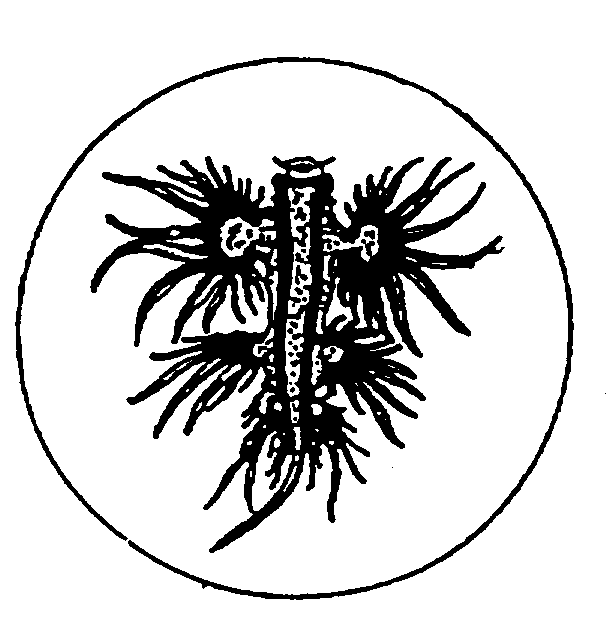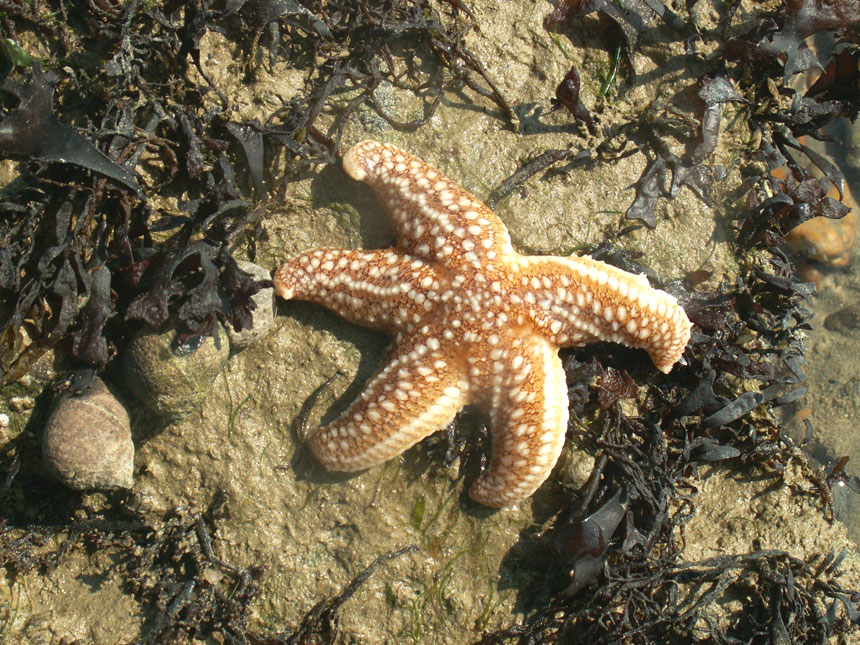Identification:
Five-armed
sea star. Usually orange, but occasionally bright red and crimson when
it could conceivably be mistaken for another species.

Breeding:
Sexes
separate. Planktonic larvae.
Habitat:
In British seas, and on
the shore when the numbers can reach epidemic proportions, the Common Starfish,
Asterias
rubens, is the most prevalent conventional starfish of the N.E. Atlantic
Ocean. It is an Arctic-Boreal species with a maximum temperature tolerance
of about 22° C.
Usually found on the mussel
beds offshore.
Behaviour:
Its
principal prey is mussels
(consuming them in their shells), but it will eat fish eggs, carrion, and
other molluscs.
 Starfish
consuming a Cockle Starfish
consuming a Cockle

Common
Starfish eating a mussel
from
Southwick Beach 2012
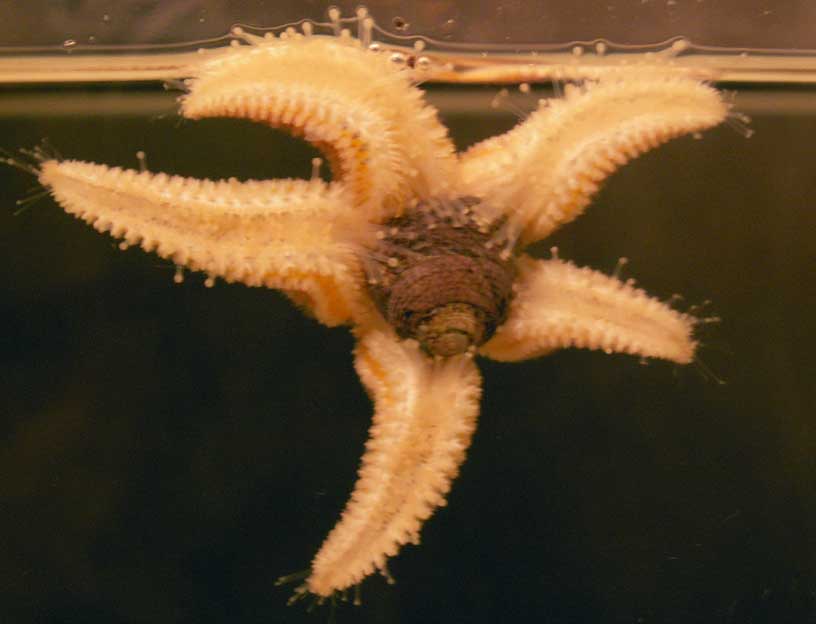
Asterias
feeding on a Grey Topshell
 Enemies:
Common
Sunstar, Crossaster papposus. Enemies:
Common
Sunstar, Crossaster papposus.
Reports:
1 June
2014
At
Shell Island,
Llanbedr, Gwynedd,
North Wales LL45 2PJ. I saw thousands of Asteria
rubens washed up on the shore, some
dead and some dying. Many were a washed out white and long dead, others
were pink/orange and some were purple. Most were of equal size, roughly
10 cm across, though there were a large number half that size.
 |
20
August 2012
An
early morning mussel collecting visit to Kingston
Beach on a low spring tide
found the unprecedented frequent (30+) occurrence of very small Common
Starfish Asterias rubens on the
underside of rocks just above Chart Datum.
Full
Report |
 14
March 2010 14
March 2010
Thousands
of Common Starfish,
Asterias
rubens, were washed up on the strandline
on the shingle beach at
Budleigh
Salterton in south Devon (East
Devon AONB). The line of washed up starfish
stretched for over a mile.
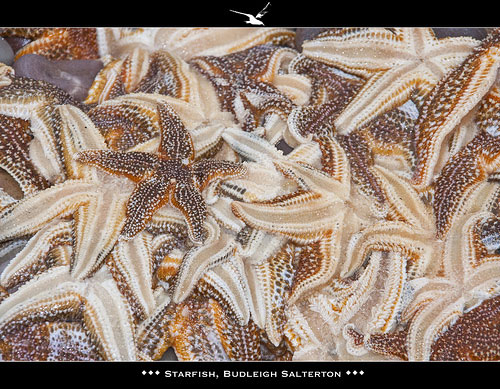
Starfish at Budleigh Salterton
Photograph by Tony
Herbert on flickr
9 December
2009
An
exceptional mass stranding of millions (a galaxy) of Common
Starfish,
Asterias rubens, stretched
in a broad band for over a quarter of a mile on Holkham
Beach on the north coast of Norfolk.
Their
usual residence would be feeding on the mussel
beds offshore. From a previous occurrence underneath the chalk cliffs east
of Brighton Marina,
Sussex, it is my surmise that the mass migration occurs because the Common
Starfish have exceeded their food supply offshore.
Perhaps, this occurs because of commercial dredging of the mussels.
In this case the stranding could have been exacerbated by north-easterly
gales.
26
March 2008
After
a recent bout of northerlies in North Wales I took the dog for a walk down
on Red Wharf Bay
on Anglesey and found
all sorts of things washed up. Common Starfish,
Asterias
rubens, were very abundant, as a rough guess at 5-10 per square
metre, amongst the rest of the wreck.
Full
Report
23
March 2008

Over Easter,
after some heavy storms with snow blowing in off the North Sea, I discovered
hundreds of Common Starfish,
Asteria
rubens, a lot of Sunstars,
Crossaster
papposus, and Brittlestars
washed up on the sands of Holkham
Beach,
Norfolk.
17
March 2008
After
the storms and the report
of a mass stranding of Common Starfish,
Asteria
rubens, on Brighton Beach, I inspected
the strandline on Shoreham Beach. All along
the strandline there was a greater number of hundreds of thousands of Slipper
Limpets and tens of thousands of Whelk
egg balls
amongst the usual mixed shell
collection including Whelks
and Oysters.
One Undulate Ray eggcase
looked in good condition and was placed in an aquarium in case the embryo
was still alive. There were a few dozen dead Starfish
at the Old Fort, but not the hundreds reported from Brighton
beach.
To
qualify as nationally newsworthy a Common
Starfish stranding must be in tens of thousands.
Sussex
Marine Life Reports
4 -5
March 2008
Hundreds
of thousands (perhaps many more) of Common
Starfish,
Asteria rubens, were
washed on the shore of east Kent.
Picture
Link
1 January
2007
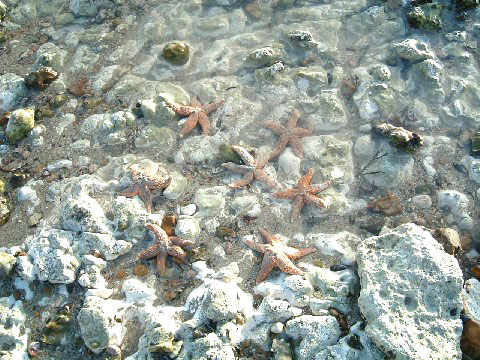
Common
Starfish on the chalk bedrock at Seaford
Photograph
by Wednesday Livingstone
The thousands
of
Common Starfish,
Asteria rubens
on Seaford Head beach, East Sussex, were now reduced to about fifty seen
on a small patch at low tide.
22
May 2006
Thousands
of dead Common Starfish,
Asterias
rubens, were seen on the beach at Lydd-on-Sea, Kent. All the starfish
were strewn along the high tide line, and for every step I took I passed
20 to 30 dead starfish. I walked about half a mile along the beach and
the line of dead starfish seemed never ending in both directions. Some
of the starfish were laying on the sand and in the sand pools but these
too were dead. Also, about 30 Sea Mice,
(an annelid worm), Aphrodite aculeata, were
found washed up dead.
NB:
This discovery followed two days of gales.
28
January 2006
Thousands
of dead specimens of the Common Starfish,
Asterias
rubens, were washed up on the beach about a mile and a half to the
north of Tywyn
on the Cardigan Bay coast of north Wales.
There seem to be various interpretations of these mass strandings, including
winter storms and changes in water temperature.
17
March 2002
Thousands
of Common Starfish,
Asterias
rubens, were washed up on the beach at Holkham, Norfolk, on the east
coast of England after sustained north-easterly gales.
31
December 2001
Thousands
of Common Starfish, Asterias
rubens, are discovered washed up dead on the shore at Formby, Merseyside,
Lancashire.
Starfish
Strandings Message Index
Information wanted: Please send any
records of this invertebrate, with location, date, who discovered it, how
it was identified, prevalence, common name and any other details to Shorewatch
Project EMail Glaucus@hotmail.com

All messages will receive
a reply.
|
